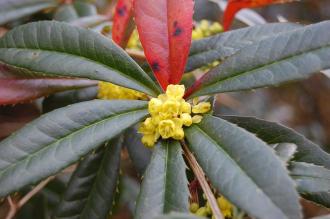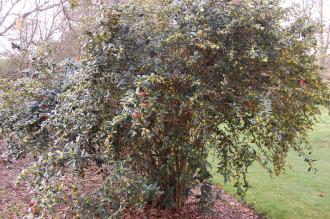
Berberis julianae flower (11/03/2012, Kew, London)
Position: Full sun to partial shade
Flowering period: Spring
Soil: Moist, well drained
Eventual Height: 4m
Eventual Spread: 4m
Hardiness: 5a – 9a
Family: Berberidaceae
Berberis julianae is a fast growing, rounded, evergreen shrub with an arching habit. Its dark green evergreen leaves are glossy, narrow, rigid with spiny margins. The leaves are pale green on the underside, its young leaves are copper in color and before old leaves fall of the plant in autumn/ spring they turn brilliant red. The stems of this shrub contain large spines. The yellow slightly fragrant flowers of the plant are borne in axillary clusters or racemes. The egg shaped fruit is a small black berry.
Berberis julianae, commonly known as Wintergreen barberry, Julians Barberry or Chinese barberry, is native to Central China. It was introduced into cultivation in the UK in 1900. It was first recorded in the wild in the UK in 1984 and continues to be recorded.
The etymological root of the binomial name for Berberis is derived from the Arabic برباريس, the Arabic name for Breberis. Juliana is named after Juliana Schnieder by her husband Camillo Schnieder (1876-1951), and Austrian botanist and landscape architect who explored China.

Berberis julianae (11/03/2012, Kew, London)
The landscape architect may find Berberis julianae useful as an impenetrable evergreen, spring flowering informal hedge plant. Care should be taken when locating this plant as its spines will scratch.
Ecologically, B. julianae is attractive to bees as they pollinate its flowers. Birds and mammals are attracted to its fruit.
The Royal Horticultural Society has given B. julianae their prestigious Award of Garden Merit in 2002.
B. julianae prefers moist, fertile, well-drained soils. It tolerates most pH of soil. It will not tolerate waterlogged soils.
B. julianae requires little maintenance. If maintaining as a hedge it should be cut after flowering.

